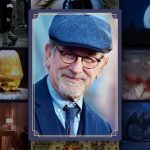You’ve seen many Steven Spielberg movies in your time. Despite his popularity, it can be difficult to pinpoint what defines Steven Spielberg directing style. Perhaps his control of the medium is so natural and intuitive, his trademarks and cinematography techniques go unnoticed in a good way. We get lost in a Spielberg movie in a way that’s like no other filmmaker, which might just make him the greatest of all time. In this article, you’ll learn how a young Steven Spielberg climbed his way up from his first feature, Duel, up to his current work. Along the way, we’ll analyze Spielberg’s cinematic DNA to see if we can discover what makes his films so beloved.
STEVEN SPIELBERG BIOGRAPHY
Who is Steven Spielberg?
Let’s briefly touch on Steven Spielberg the person.
Steven Spielberg was born in Cincinnati, Ohio. His mother owned restaurants and played concert piano while his father worked as an electrical engineer in the early years of computers.
Young Steven Spielberg
Spielberg grew up in Phoenix, Arizona. He was a Boy Scout and earned his photography merit badge by making a short film. The family later moved to Saratoga, California where Spielberg graduated high school.
Steven Spielberg College & Education
He moved to L.A. with his father and applied to USC film school. He was rejected “due to his poor grades.” He was accepted to Cal State Long Beach and then earned an unpaid internship at Universal Studios in the editing department. He then made a 34-minute short film, Amblin’.
The film was good enough to earn him a seven-year directing contract from Universal vice president, Sidney Sheinberg. This inspired Spielberg to drop out of college — though he would return and graduate in 2002.
Steven Spielberg Facts
Collectively, his films have grossed more than any other director in history, and his net worth is $3.7 billion. His production company, Amblin Partners, oversees productions through shingles including DreamWorks Pictures, Participant Media and Amblin Entertainment.
So, let’s jump into his filmmaking style and cinematography techniques.
STEVEN SPIELBERG PRODUCTION DESIGN
Set the scene with production design
One thing I’ve noticed about many scenes in the best Steven Spielberg films is that they very often begin with production design elements. In other words, the scene will start with a particular prop or piece of set dressing that helps contextualize the scene immediately.
It’s also a nice visual reset for the viewer, so that way we all know we’re beginning a new scene. Sometimes this opening shot can add context to the overall story, especially when combined with the previous scene.
For example, in this scene from Jurassic Park, the film transitions to a completely different setting but helps us focus on the essence of the scene first. This tells us very quickly where we are, who we’re about to meet, and what this scene is ultimately about.
That way, the audience is bombarded with new setting, new characters, and dialogue that might confuse or disorient them.
https://www.youtube.com/watch?v=yVCkuJFnA4k&ab_channel=SilverMovies
It’s nice to see little details as well, and it shows an appreciation for the work and for science in general. We get an establishing shot that shows us very little of the surrounding area, but we understand the purpose.
STEVEN SPIELBERG PERFORMANCE BLOCKING
Build kinetic and subtextual blocking
Steven Spielberg movies use performance blocking that moves the actors through the scene. Spielberg mainly does this for two reasons:
- Provide kinetic energy
- Inform on a subtextual level
As the mood and stakes of a scene change, so will the positioning of the actors. Visual choices are the lifeblood of a film director, and while sound and music can signal emotional information, the best visual tool is an actor’s physical movement and location relative to the camera.
This scene from Lincoln begins on the letter (which supports the previous example) but watch the blocking in the scene. Stephens (Jack Earle Haley) begins with his back turned to Grant, a sign of disrespect. When he turns, Grant (Jared Harris) is towering over him, and right in his face, but still polite.
There are more men on the Union side compared to the confederate side, which suggests that the war is not going well for the South. Grant walks away after relaying the ‘disappointing’ news to Stephens. Grant takes his tea and discusses peace. Then he explains how there is just one country — not two.
Spielberg then breaks the 180 degree rule just as Grant finishes his point and gives Stephens a conciliatory pat on the shoulder.
Then Grant crosses the room to sit down and drink his tea. He has made his point and is both confident and relaxed enough to sit down. Most would think that sitting down is a sign of weakness, but Spielberg knows that, in this case, it’s a sign of stability. It’s a sign of calm resolve.
STEVEN SPIELBERG SHOT COMPOSITION
Create shots with many compositions
Great directors don’t simply build a single shot. They build many shots within a single shot, alternating between compositions. This really is one of the best Steven Spielberg trademarks because the change in shot size:
- Evokes emotion
- Directs attention
- Keeps things interesting
Often, the goal is to create a willing suspension of disbelief in the viewer, especially with the kind of movies directed by Steven Spielberg. He can’t risk pulling the viewer out of important moments with a jarring cut.
This fluid cinematography technique isn’t easy to achieve, and requires a lot of practice, rehearsals, and a talented film crew. That doesn’t mean it’s impossible, but you should plan composition shifts in a shot list.
Check out the storyboard below made using StudioBinder’s storyboard software, where we split a single shot into the various compositions. This scene is from Munich, and this specific portion is the run up to the first assassination in the movie.
Avner and his team follow this member of Black September before dispatching of him in an elevator lobby.
Spielberg uses zoom shots and fluid camera movement to shift shot composition throughout a single camera setup. It switches from a full shot, to a medium shot, to a medium close, to a long shot, and back to medium close — all without cutting.
This camera work is distinct to a style used in many 1970s espionage films and it transports the viewer. Spielberg’s movies are truly amazing.
In this video, we look at how Spielberg shoots ‘oners’ in Jurassic Park. Again, they’re not just long takes for their own sake. They help give the visuals energy while luring the audience into the scene.
STEVEN SPIELBERG FILMMAKING STYLE
Move the camera in XYZ Space
One of the most important cinematography techniques used in Steven Spielberg movies is also one of the least discussed. Spielberg and his team find a way to move the camera in every direction.
They don’t track laterally, or dolly in, or crane up and down — they do all of these in a single shot. The movement is complemented by the performance blocking, production design, and background elements.
https://youtu.be/1BCbd7EFczg
This filmmaking style supports the sort of cinematic adventure film Spielberg makes, but also the mature and dramatic films as well.
The change in speed is a defining factor, as well as the equipment used to achieve the camera movement. He also builds a static lens plot, explained in the video below:
Steven Spielberg built a static lens plot in Schindler’s List, and completely avoided using a techno-crane on the film because he wanted to ground the viewer inside the tragic events of the Holocaust.
To use fast and opulent camera sweeps across the ghettos and concentration camps would have been completely tone-deaf, and inadvertently glorified their use. Be thoughtful with your camera.
STEVEN SPIELBERG CAMERA MOVEMENT
Perfect motivated camera movement
To continue on the topic of camera movement, Spielberg is the king of motivated camera movement. The operative word here is motivated.
If a character reaches down to grab something…Spielberg may tilt down to show us the action.
If a side character calls out to the main character…Spielberg may pan over to show who called out.
The reason I say ‘may’ is because some moments won’t need this particular cinematography technique, but it’s a trademark of Steven Spielberg filmmaking that helps to define his special style.
If you want to incorporate the style used by Steven Spielberg movies, this is one trademark you can use in your next project. Consider finding moments in your script that call for motivated camera movement.
STEVEN SPIELBERG MOVIES
Use eye trace to direct the viewer
Eye trace is the term for directing the viewer’s eyes through movement, light, color, and any other method that isn’t an actual cut. You can use eye trace to carry directing through a cut, but this is different than physically cutting to say, an insert shot of a scene element.
Really pay attention as you take a look at this scene:
Go back and really watch how every decision — the money, the blocking, the waiter moving through the room is strategically built to move our eyes (and the eyes of the characters) toward Oskar Schindler.
This is a classic Steven Spielberg trademark — directing your eyes.
STEVEN SPIELBERG TRADEMARKS
Have characters enter and exit frame
One of the main things I notice about Steven Spielberg movies is how he constantly has actors entering and exiting the frame. He does this with important characters — not simply background actors.
This cinematography technique does a few things. It gives the scene visual variety, suggests a world outside the frame, and allows us to focus on fewer characters.
A big part of this isn’t just beginning or ending scenes with characters entering and exiting the frame. But also doing it in the middle of the scenes. Filmmakers are often so fixated (as they should be) on the imagery that will be on screen that they almost psychologically block out the idea that the space around the characters even exists.
If you want to emulate the Steven Spielberg directing style, make sure to have characters enter and exit the frame to intro scenes, to punctuate scenes, but also everywhere in between.





